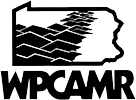
for Abandoned Mine Reclamation

|
Western Pennsylvania Coalition for Abandoned Mine Reclamation History |
by Paul HeyworthThe Western Pennsylvania Coalition for Abandoned Mine Reclamation (WPCAMR) was formed in 1981-82. The general purpose was to encourage the reclamation and development of abandoned mine lands in the bituminous coal area of Western Pennsylvania, with emphasis placed on improving water quality. The goals also included reducing erosion and health and safety hazards. The founders also wanted to return abandoned mine land to productive use and to improve the local and regional economy. To this end the group strove to save and enhance the Rural Abandoned Mine Program (RAMP) as implemented under the Surface Mining Control and Reclamation Act of 1977 (SMCRA). More specifically they worked to increase funding to reduce abandoned mine drainage pollution at the federal and state levels. These goals were to be accomplished primarily, but not exclusively, through conservation districts which became the governing membership of the coalition. The coalition reached a peak of 24 member counties in the late 1900s. Considerable time and energy was spent in trying to convince the Bureau of Abandoned Mine Reclamation to include water quality improvement as major if not paramount consideration in reclamation work. Leaders traveled to Washington, D.C. to testify before congressional committees for the continuance and expansion of RAMP and to get more money for local reclamation projects out of the SMCRA's Abandoned Mine Land Fund. The coalition worked to elevate mine drainage issues from low priority III status to priority II status under SMCRA. WPCAMR leaders were also instrumental in the formation of the National Coalition for Abandoned Mine Reclamation (which grew out of the RAMP movement). With the hiring of Mark Killar as WPCAMR’s first regional coordinator, WPCAMR intensified these efforts and was successful in participating in federal and state development activities. WPCAMR worked with the USDA’s Natural Resources Conservation Service (NRCS), Resource Conservation and Development Councils (RC&D's), the Office of Surface Mining (OSM), and the Environmental Protection Agency (EPA). The coalition also worked with DEP units such as the Bureau of Abandoned Mine Reclamation (BAMR), the District Mining Offices (DMO’s), and the Office of Water Management (OWM) and the Office of Mineral Resource Management (OMRM). WPCAMR worked with the Pennsylvania Association of Conservation Districts to form the Eastern Coalition in the anthracite region. In 1994, with the advent of EPA's Non-Point Source Section 319 funding, administered by the DEP's Bureau of Watershed Management, WPCAMR added a staff member and moved into the treatment arena to help conservation districts and other groups install 16 AMD pollution abatement projects. The coalition is currently trying to assure the continued maintenance of those projects. WPCAMR was deeply involved in AMD education, holding a major seminar for agency officials, watershed groups and foundations in 1993. The coalition has consistently worked on conferences and used a number of other devices to enhance public education and relations. Killar helped with the creation of the "Good Samaritan Act" (to protect landowners from adverse legal repercussions from AMD control projects) which in part evolved into the law creating the state's $650 million Growing Greener program. WPCAMR was instrumental in the creation of a Water Quality Technical Advisory Committee with broad private and public sector membership. The committee helped in the selection of best possible projects for construction. The availability of Growing Greener funding has led WPCAMR into a variety of projects, from a study of the formation of an Ohio River Basin group to creating a state model for the evaluation and prioritization of mine refuse piles. As a part of the coalition's evolving direction, a "watershed specialist" was added to the staff to work with associations and other groups to improve water quality in the region.. WPCAMR is also using Growing Greener funding to educate local decision-makers about AMD, to create a website clearinghouse aimed at watershed associations and to digitize Scarlift reports. The coalition is involved in a number of outreach projects such as working with DEP to inform the public about the AMD impact of LTV Steel Company's bankruptcy. |
|
PO Box 295 Luxor, Pennsylvania 15662 © Western Pennsylvania Coalition for Abandoned Mine Reclamation |